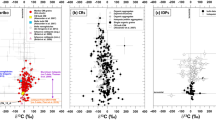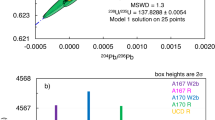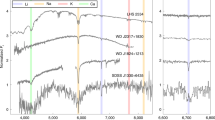Abstract
Until now, light-element isotopic anomalies have been confined to primitive chondritic meteorites. Bencubbin, an unusual breccia found in Australia, comprising 60–75% metal with silicate and chondritic clasts1–4 in a shock-welded matrix5,6, has been shown7–9 to contain an unprecedented enrichment (by a factor of 2) of 15N, presumably a nucleosynthetic product which escaped homogeniz-ation in the solar nebula. Here we show that virtually all the nitrogen in Bencubbin is enriched, with a maximum δ15N of +1,033‰. The nitrogen resides in two acid-resistant components, one more so than the other, which are present in different proportions in the metal and silicate. The more resistant component could be carbonaceous, with an unusually low C:N ratio and without an anomalous carbon isotopic composition (δ13C ≃ +25%‰). Another possible host is a chromium-rich sulphide, which would indicate processing in a supernova10.
This is a preview of subscription content, access via your institution
Access options
Subscribe to this journal
Receive 51 print issues and online access
$199.00 per year
only $3.90 per issue
Buy this article
- Purchase on Springer Link
- Instant access to full article PDF
Prices may be subject to local taxes which are calculated during checkout
Similar content being viewed by others
References
Simpson, E. S. & Murray, D. G. Mineralog. Mag. 23, 33–37 (1932).
Lovering, J. S. Researches on Meteorites (ed. Moore, C. B.) 179–197 (Wiley, New York, 1962).
McCall, G. J. H. Mineralog. Mag. 36, 726–739 (1968).
Mason, B. & Nelen, J. Geochim. cosmochim. Acta 32, 661–664 (1968).
Newsom, H. E. & Drake, M. J. Geochim. cosmochim. Acta 43, 689–707 (1979).
Hutchison, R. Lunar planet. Sci. XVII, 374–375 (1986).
Prombo, C. A. & Clayton, R. N. Lunar planet. Sci. 16, 679–680 (1985).
Franchi, I. A. et al. Meteoritics 20, 645–646 (1985).
Prombo, C. A. & Clayton, R. N. Science 230, 935–937 (1985).
Clayton, D. D. & Ramadurai, S. Nature 265, 427–428 (1977).
Prombo, C. A. & Clayton, R. N. Meteoritics 18, 377–379 (1983).
Burgess, R. et al. Lunar planet. Sci. 16, 99–100 (1985).
Ramdohr, P. The Opaque Minerals in Stony Meteorites (Elsevier, Berlin, 1973).
Thiemens, M. H. & Heidenreich, J. E. Science 219, 1073–1075 (1983).
Begemann, F. et al. Geochim. cosmochim. Acta 40, 353–368 (1976).
Lewis, R. S. Meteoritics 20, 698–699 (1985).
Audouze, J. & Vauclair, S. Introduction to Nuclear Astrophysics (Reidel, Dordrecht, 1980).
Author information
Authors and Affiliations
Rights and permissions
About this article
Cite this article
Franchi, I., Wright, I. & Pillinger, C. Heavy nitrogen in Bencubbin—a light-element isotopic anomaly in a stony-iron meteorite. Nature 323, 138–140 (1986). https://doi.org/10.1038/323138a0
Received:
Accepted:
Issue Date:
DOI: https://doi.org/10.1038/323138a0
This article is cited by
-
A Comparison of Presolar Isotopic Signatures in Laboratory-Studied Primitive Solar System Materials and Comet 67P/Churyumov-Gerasimenko: New Insights from Light Elements, Halogens, and Noble Gases
Space Science Reviews (2023)
-
Presolar Isotopic Signatures in Meteorites and Comets: New Insights from the Rosetta Mission to Comet 67P/Churyumov–Gerasimenko
Space Science Reviews (2018)
-
The Genesis Solar Wind Concentrator: Flight and Post-Flight Conditions and Modeling of Instrumental Fractionation
Space Science Reviews (2013)
-
Measurement of mercury isotopic ratio in stone meteorites by neutron activation analysis
Journal of Radioanalytical and Nuclear Chemistry (1997)
-
15N-enriched nitrogen in polymict ureilites and its bearing on their formation
Nature (1988)
Comments
By submitting a comment you agree to abide by our Terms and Community Guidelines. If you find something abusive or that does not comply with our terms or guidelines please flag it as inappropriate.



